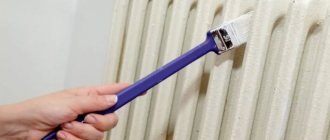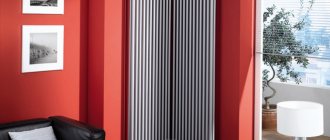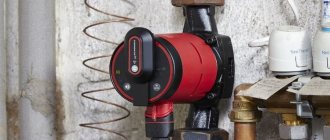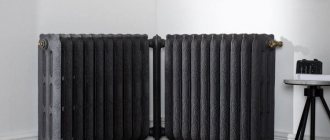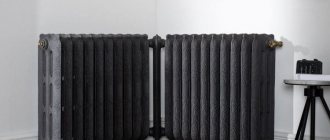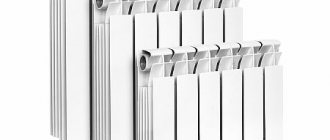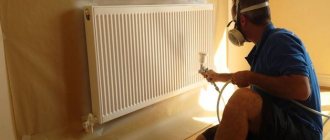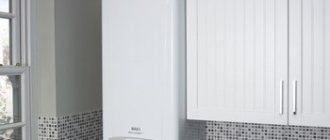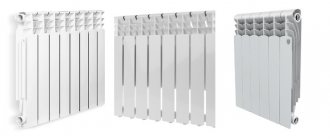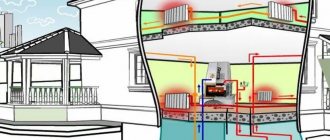Thanks to painting, heating batteries become more presentable and receive additional protection against corrosion. But the paint for heating radiators must be chosen correctly so that the renewed coating lasts as long as possible.
We will help you in this matter. The article lists the requirements for enamels and describes the advantages and disadvantages of different paints. There is also an overview of companies whose paints and varnishes have proven wear resistance in practice.
DekArt MA 15
The manufacturer recommends using paint for treating metal heating pipes. Since the palette of shades is wide, the batteries can be painted in any color, taking into account the characteristics of the overall design of the room.
Advantages:
- high surface protection from aggressive influences;
- wide palette of bright colors;
- the ability to give a pleasant appearance to the radiator, adapting to the interior of the room.
One of the downsides is the pronounced smell.
When to dye
A question that worries many: when is it advisable to paint batteries - before or during the heating season. In some regions, the cold season lasts a long time and the heating season takes at least 6 months, so not everyone can wait for the onset of warm weather to update the appearance of the batteries. In this regard, modern manufacturers offer paint that can be applied to warm radiators.
However, if possible, it is better to paint the batteries in the warm season, when the heating is turned off. There are two reasons for this. When painting hot batteries with an acrylic composition, it will dry out instantly, which will not allow for uniform and high-quality painting of the surface.
The second reason is the presence of an unpleasant odor, which is emitted by all compositions when stained. When applied to a hot surface, the strength of the odor increases several times.
In summer, it is possible to provide high-quality ventilation in the room or completely remove the radiator to carry out painting work in the fresh air.
Video - How and with what to paint a heating radiator?
Sniezka Supermal
Paint has been developed for heating radiators made of cast iron and steel. The product can be used in public areas.
Pros:
- resists atmospheric and mechanical influences;
- low consumption;
- bright shades – 23 colors;
- products comply with all current standards.
No deficiencies were found.
Glossy or matte
When choosing paint for heating radiators, you need to choose what type of surface you want to get - matte or glossy. You need to choose based on the type of surface. The fact is that glossy paint emphasizes surface unevenness. Cast iron batteries are most often painted, but their surface is far from ideal. By covering it with a glossy composition, you will only emphasize its imperfection.
Matte compositions are better in this regard - they visually hide many irregularities. So this is a good option. But there is also a drawback: matte white paint quickly acquires a grayish tint. This happens due to the fact that dust and dirt get clogged into the pores, and they are wide in matte paint. This dirt is not washed out from there. The solution is a fresh coat of paint or painting in a color other than white. A smart choice is to match the paint to the color of the walls. From a design point of view, this is a better solution than white radiators.
Radiator Festek
This is a one-component, odorless paint for radiators, which guarantees high resistance of the coating to the negative effects of water. After painting, the batteries have a nice matte white color.
Advantages:
- no odor;
- high resistance to moisture and dry abrasion;
- lack of yellowness;
- ability to withstand heat up to 95 degrees;
- quick drying.
The only disadvantage is vulnerability to increased operational loads.
Video description
See how quickly you can restore a cast iron battery using spray paint:
Another representative of this group is hammer paint. This is the same alkyd enamel on an organic basis, but with the addition of wax, aluminum flakes and other fillers, creating an impressive hammer-chased texture on the surface that hides all irregularities well.
The most popular products of this type are Hammerite primer enamels, which can be applied directly to rust, eliminating pre-priming and anti-corrosion treatment from the technology.
HAMMERITE hammer paint for metal and rust Source images.obi.ru
Remontti Assa Tikkurila
This is a Finnish good paint for batteries, which contains an acrylate binder. At the same time, the manufacturer did not use organic solvents. The products are absolutely safe for people suffering from allergies or asthma.
Advantages:
- the dye is made using innovative technologies and high-quality materials;
- high security;
- resistance to washing and abrasion.
The only downside is the high price of the product.
Brief overview of manufacturers
Heat-resistant paints and varnishes for painting heating systems, both imported and domestic, are available for sale. Both of them are quite suitable for painting batteries in a cottage or apartment.
Among the main manufacturing companies we can mention:
- Scandinavian TIKKURILA with the “Termal” series.
- German DUFA series “Thermo” and “Aqua-Heizkorperlack”.
- Russian TEX with special “enamel for radiators”.
- Polish SNIEZKA .
- Slovenian BELINKA .
- Russian LAKRA .
There are many options with different prices and composition, there is plenty to choose from. Moreover, when choosing a primer for paint, it is best to opt for products from one manufacturer. There is no point in experimenting with mixing what is cheaper.
An overview of popular thermal paints that are used for painting radiators, metal stoves and other elements of the heating circuit is given in this article.
Balakryl Radet
This high-quality product can be used to paint heating radiators in residential and industrial buildings.
Advantages:
- can be used in rooms where there is high humidity;
- can withstand temperatures of 100 degrees, so the coating on heating radiators does not lose its original appearance for a long time.
There were no deficiencies found in this paint product.
Rules for painting heating appliances
Painting radiators requires special tools. For example, a curved brush, so buy everything you need in advance. The painting process always begins with preparatory activities and only after that the work begins.
Painting cast iron heating radiators.
Preparatory stage
To make painting batteries comfortable, you need to prepare a number of materials and tools in advance. Namely:
- paint;
- 2 brushes – curved and straight;
- primer;
- solvent (except water-dispersion enamel);
- old rags;
- newspapers or polyethylene;
- sanding paper (No. 2);
- protective equipment - rubber gloves, respirator.
If the radiator has already been painted, it must be cleaned of the old coating. Of course, applying from above is acceptable, but this will significantly reduce the level of heat transfer.
After removing the old paint, proceed as follows:
- Sand the surface with an abrasive material to make it smooth.
- Wash with a cloth and detergent.
- Wipe dry - there should be no moisture on the batteries.
- Degrease with solvent - there should not be the slightest grease.
- After drying, treat with a primer.
Tikkurila Empire
If you haven’t decided what paint to paint the batteries with, then you should turn to this development of Finnish specialists. Use a ready-made concentrate and white spirit diluent. After applying the product, the surface becomes semi-matte.
Advantages:
- minimal risk of smudges when painting;
- maximum adhesion to metal surfaces;
- no odor;
- wide palette of shades;
- easy and quick application.
Flaws:
- To apply paint, the room must have an air temperature of 5 degrees and a humidity of 80%;
- careful preparation of the battery is necessary for successful staining;
- high consumption - 12 liters per 1 m2.
Popular vote
What paint for heating radiators would you choose or recommend?
Enamel "Olecolor"
9.30 % ( 4 )
Enamel “TEX Profi”
9.30 % ( 4 )
Enamel "DALI"
6.98 % ( 3 )
Enamel "Prestige Premium"
0.00 % ( 0 )
Enamel "Krafor"
0.00 % ( 0 )
Enamel “AURA LUXPRO TERMO”
16.28 % ( 7 )
Enamel "TEX Universal"
9.30 % ( 4 )
Enamel "Dekor"
6.98 % ( 3 )
Enamel "Lakra"
13.95 % ( 6 )
Enamel “Prestige Ferrum Premium”
6.98 % ( 3 )
Enamel "ETUDE"
4.65 % ( 2 )
Enamel "MOTIP Deco"
4.65 % ( 2 )
Enamel “Decorix 0105-04 DX”
2.33 % ( 1 )
Enamel "Vixen"
0.00 % ( 0 )
Sadolin Master 30
This Swedish product is suitable for painting metal batteries. Makes the surface semi-matte with a pleasant shine.
Advantages:
- high protection against corrosion, rot, mold and mildew;
- no smudges during painting;
- high resistance to atmospheric influences;
- abrasion resistance;
- fits perfectly on different surfaces;
- wide choice of shades.
The downside is the faint smell of paint, so you need to ventilate the room after work.
Video description
The process of removing old paint from a cast iron battery using a remover is shown in the video:
The next stage is priming the surface. It is advisable to choose a composition for this on the same basis as the selected paint. For example, radiators under alkyd enamel can be primed with GF-021, which has an anti-corrosion effect.
Advice! Before painting a battery in a living room, you need to protect the floors, walls and nearby furniture from accidental paint on them - cover them with film, newspapers or packaging cardboard.
You can begin painting after the primer has dried. If it is done manually, it is advisable to use two brushes: one curved on an elongated handle for hard-to-reach places and a second regular one for the front surface. Both should have natural bristles.
This brush will allow you to reach the most difficult areas of the radiator Source gidpokraske.ru
Painting begins with the internal surfaces, leaving the façade for last. As a rule, a minimum of 2 passes is required to achieve a smooth and evenly colored surface. The second layer can be applied after the time specified in the instructions and necessary for complete drying.
Professional Gloss JOHNSTONE'S
British paint developed for painting metal batteries. It is based on a durable alkyd resin that provides a durable finish.
Advantages:
- perfect coverage;
- pleasant gloss;
- high resistance to negative external influences: shock, temperature.
The disadvantages of the product include the high price.
Powder dyes
With the help of such dyes, steel, bimetallic and aluminum batteries are painted under production conditions. For home painting, it is used very rarely due to the need for a special tool - a spray gun. Although some services rent out such equipment.
According to the technology, a negative charge is transferred to the cleaned part, and a positive charge to the powder paint. To do this, you need a diesel generator that produces current at a voltage of 25-30 kV with a power of a fraction of an ampere.
The potential difference allows the powder to be evenly sprayed over the entire surface to be painted. The next step is to polymerize the dye so that it becomes rigid. It is performed by heating the product to a certain temperature. Its range is from 170-200℃ to 350℃.
The lower temperature threshold can be created with a heat gun, but to pump up high temperatures you will need a furnace that will gradually warm up the product. Alternatively, you can use paint that polymerizes under the influence of ultraviolet radiation. Then in a closed room it is enough to turn on a special lamp for a specified time.
Be that as it may, such technology is difficult to implement at home. You may be able to have your radiator painted in an equipped auto repair shop.
Which paint to choose
When looking at numerous photos of battery paint, you need to pay attention not only to the picture with the result, but also to know the composition and characteristics of the product:
- Oily. This is a budget option, which is presented in a wide range. But after painting, you will have to wait a long time for the dye to dry and endure a strong, unpleasant odor.
- Acrylic. These dyes dry quickly and do not smell, but it is not always possible to get the perfect shade.
- Alkyd. After their application, the coating is not afraid of high temperatures and mechanical factors. But during painting there is an unpleasant odor.
- Heat resistant. An excellent choice for heating radiators, as the coating remains white without yellowing and withstands high temperatures.
If you buy the right paint and take into account all the recommendations for its application, you can update the condition of the radiators, slightly change the overall design of the room and enjoy the result for a long time.
Is it possible to paint batteries?
There should be no problems with painting old, good-quality cast iron batteries. You just need to choose the right paint for them. But with radiators made of aluminum or stainless steel, the situation is completely different.
Initially, they are painted in a factory using the powder method with heat treatment. It is problematic to apply a new layer of paintwork on top of this paint coating at home with your own hands.
The vast majority of manufacturers of heating devices not made of cast iron consider unauthorized painting of the surface of the battery as a reason for voiding the factory warranty.
Any damage or peeling of the paint layer on a newly purchased radiator is a manufacturing defect. Such equipment is subject to mandatory replacement. No one has yet canceled the service warranty period.
Manufacturers of aluminum and steel radiators in the instructions for their products categorically prohibit their additional painting
After drying, enamel paints create a durable and monolithic layer on the surface, through which air, by definition, cannot pass.
If oxygen is left with even a small chance to seep through the paintwork, then you can immediately forget about protecting the metal from corrosion. And protective functions are often the main reason for painting radiators.
At the same time, in the passports for all heating batteries there is a categorical prohibition on painting over the air outlet of the automatic air vent. If you apply paint to it, it will be impossible to bleed air from the heating system if necessary. This point must be monitored during painting work.
Both aluminum and stainless steel are painted in factories using powder paints, which, after application, are “baked” in special boxes at high temperatures. It is impossible to create the necessary conditions at home yourself.
But ordinary oil and other paints do not last long on such radiators. Due to their low adhesion, they will inevitably peel off aluminum and steel surfaces.
If the paint on an aluminum battery begins to peel off, then it is easier to buy a new radiator - a paint layer applied at home can last a maximum of two to three years
Reliably painting aluminum requires specialized painting equipment, as well as epoxy primers and enamels. All this costs a lot of money.
In addition, the slightest failure to comply with the technology inevitably leads to peeling of the applied coating. There is also an option with anodic oxidation, but this is again technologically complex and requires certain knowledge.
If you have successful experience in painting a car body and the appropriate paint and varnish materials, then you can take on painting an aluminum battery, otherwise it is not worth doing. It is better to purchase a new heating device or simply cover the peeling one with a decorative screen.
A separate topic is convectors with private fins made of steel plates (“comb”) strung on a pair of pipes. Such batteries were often installed in panel high-rise buildings in the 1970–80s. The lamellar ribs themselves cannot be painted. This will lead to a sharp decrease in heat transfer.
At the same time, it will also not be possible to get to the pipes in the middle even with the help of a very narrow brush. These surfaces are best left alone.
Such radiators usually have dampers and decorative screens made of iron. They can and should be painted to give them an aesthetic appearance. Regular heat-resistant paints will do here.
Photo of paint for heating radiators
Carrying out priming
To implement the primer, you can use the domestic composition GF-021, which is combined with MA and PF enamels. If you plan to use imported dyes, then for priming you should purchase material from the same manufacturer. Oil paint, applied in one layer over the primer, can increase the heat transfer of the battery by 5%. If more than three layers are applied, the heat transfer will decrease by 1%. Dye based on lead and aluminum will also help reduce heat transfer.
